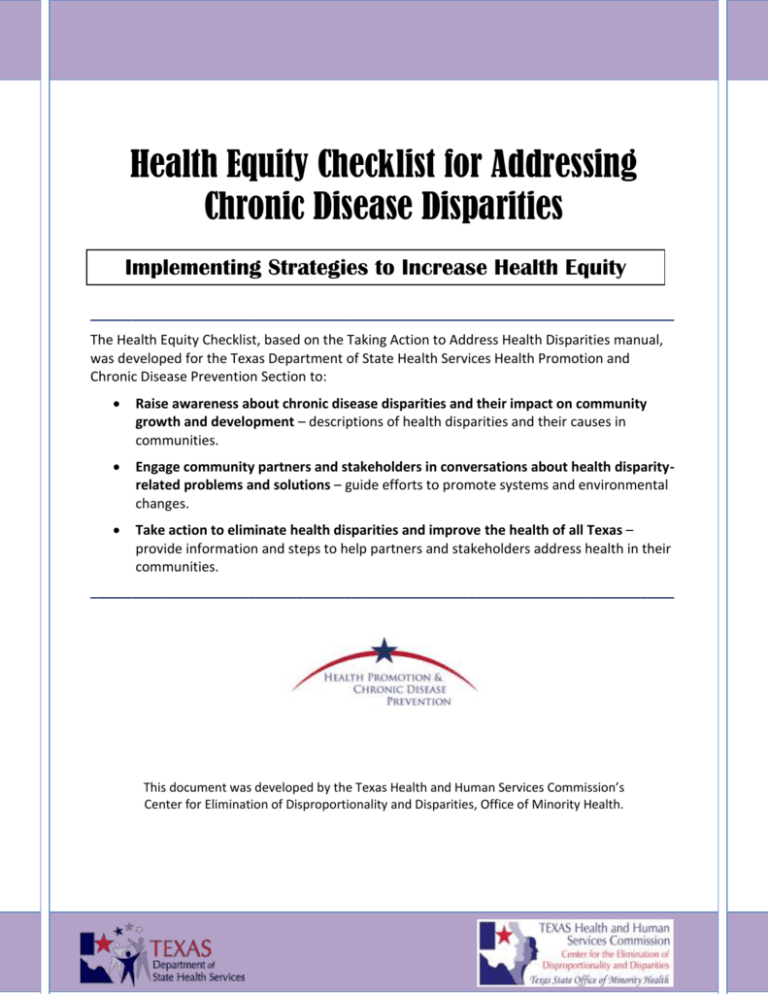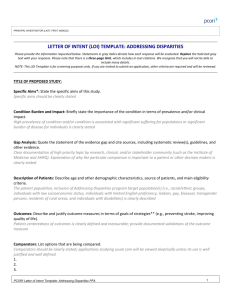Health Equity Checklist for Addressing Chronic Disease Disparities
advertisement

Health Equity Checklist for Addressing Chronic Disease Disparities Implementing Strategies to Increase Health Equity _____________________________________________________________________________________ The Health Equity Checklist, based on the Taking Action to Address Health Disparities manual, was developed for the Texas Department of State Health Services Health Promotion and Chronic Disease Prevention Section to: Raise awareness about chronic disease disparities and their impact on community growth and development – descriptions of health disparities and their causes in communities. Engage community partners and stakeholders in conversations about health disparityrelated problems and solutions – guide efforts to promote systems and environmental changes. Take action to eliminate health disparities and improve the health of all Texas – provide information and steps to help partners and stakeholders address health in their communities. _____________________________________________________________________________________ This document was developed by the Texas Health and Human Services Commission’s Center for Elimination of Disproportionality and Disparities, Office of Minority Health. The Health Equity Guide presents a process that can be used depending on infrastructure, capacity, and resources inherent to the Section program that is being implemented. The purpose of this guide is to improve the health of disparate populations through the development and implementation of equitable health promotion and chronic disease prevention programs. If you or your program staff are not able to “check off” each item on the list because you do not feel it is applicable to your work, having a discussion regarding the reasons why not can help ensure the process is being approached through an equity lens. You can use the checklist below to track, monitor, evaluate, and update the activities as they are completed for each of the ten steps outlined in this document. Step 1: Gathering Data and Assessing Health Disparities for Chronic Disease Prevention The first step is gathering health data to gain understanding of state-wide and local demographics, along with disease burden data. Gathering data on chronic diseases, associated risk factors, and the social and environmental factors that can contribute to chronic disease is an important step toward addressing health disparities. Gathering data on chronic disease burden: Did you decide on the best method for gathering and accessing chronic disease data specific to your program, in order to identify disparities? Do you have staff members in your program that are trained to gather and analyze health data? If not, have you identified alternate personnel (e.g., Office of Surveillance, Evaluation, and Research (OSER) staff, staff from other Health and Human Services (HHS) agencies, external contractors, college/university staff, etc.) to provide such services? Did you decide upon the variables (e.g., race, ethnicity, age, gender, location (border, public health region, urban, etc.), etc.) that you will use to identify the population that is at greatest risk for the chronic disease(s) your program is targeting? Did you identify surveillance data systems that contain the variables you want to assess (e.g., vital statistics, disease registries, health surveys (e.g., Behavioral Risk Factor Surveillance Survey (BFRSS), Youth Behavioral Risk Survey (YRBS)), U.S. Census Bureau (Population estimates, State and County Quick Facts) etc.)? Did you collect all the data needed from traditional data sources or were data gaps identified? Each traditional surveillance system has advantages and limitations. Health data may not be available for smaller geographic areas (e.g., cities and towns). In some instances, information about disease risk and/or burden may be reported anecdotally by the public or more precisely by clinicians as "clusters" of disease to public health departments. Though state-wide programs Page 1 of 9 may not always benefit from this information, for programs targeting a specific community, these local data sources can be beneficial to understanding the community and its needs. Did you use local data sources to fill gaps in the data available through traditional sources? Did you identify local data sources (e.g., physician reports, research data from published/unpublished literature, student dissertations/theses, local health status/needs assessments, etc.) and determine how to access them? Did you decide upon ways to collect additional data (surveys, interviews, focus groups, etc.) if secondary data were not available? Did you decide upon ways to store the data for analysis (e.g., a simple electronic database), or to effectively transfer the data when they are in hardcopy only? Did you examine the analytical reports and interpret the findings? Examine how the disease occurrence varies within the population in the geographic area: After you have gathered data on the entire population, it is time to identify if there is a subpopulation that has a higher risk for or disproportionate burden of the disease. Recognizing and understanding the reasons for these differences will provide greater insight into health disparities and guide you to a more equitable approach. Did you categorize the disease burden data by demographic (race, ethnicity, age, gender, nationality, etc.) and socioeconomic (e.g., employment, income, poverty, education, health insurance, etc.) factors? Did you identify a subpopulation that is disproportionately affected by the chronic disease and/or risk factors of interest? [Note: disproportionality is the overrepresentation of a particular race or cultural group in a program or system compared to their representation in the general population. (Texas Health and Human Services Commission)] Did you identify particular regions where the identified population group is most concentrated? Did you examine the individual (e.g., race, ethnicity, age, gender, income, educational level, nationality, etc.) and geographic characteristics (e.g., people per square mile) of the community? Step 2: Assessing Organizational Capabilities Step 2 walks you through actions for promoting health equity at an organizational or programmatic level, including determining and enlisting leadership support, promoting a diverse work environment, and addressing the need for conducting adequate training on health equity. This step describes ways you can assess your organization or program’s ability to address health disparities, determine whom to involve in the organizational assessment, and identify barriers and enablers to meeting needs. While conducting resource or asset mapping, you will identify gaps in program staff knowledge, skills, and resources for addressing health disparities. Page 2 of 9 Conducting a SWOT (Strengths, Weaknesses, Opportunities, and Threats) analysis: It is useful to conduct a SWOT analysis to identify both the positives and negatives inside your program (S-W), as well as in the external environment (O-T). Developing a full awareness of your organization or program’s current status as it relates to health equity can help with strategic planning and decision-making. Did you conduct a SWOT analysis of your organization or program? Did you assess the knowledge, skills, and experience of the staff within your organization or program to address health disparities and support health equity work? Do you have bilingual staff in your organization or program to work with stakeholders or community partners whose primary language is not English? Note: Determine the level of language proficiency among self-identified bilingual staff. Did you assess the expertise among stakeholders, advocates, and interest groups in the community who can support your program’s work (if applicable)? Did you identify stakeholders or other partners that can provide in-kind services or additional insight that can help supplement the skills and expertise of your staff? Did you assess if there are other programs/interventions being conducted that have the same or similar goals as your program? Does your organization or program have the expertise to address health disparities and health equity statewide, and/or at the community level (if applicable)? Did you hire any staff or select contractors from the community (if applicable)? Does your organization or program promote a diverse work environment by attracting and hiring culturally diverse staff? Did staff receive training on health disparities/equity, and can they identify the social determinants of health? Are staff members confident in their abilities to address health disparities/advance health equity? Does staff need additional training or technical assistance on how to address health disparities/advance health equity? Step 3: Assessing Community Assets for Addressing Health Disparities An assessment of the community and the level of engagement in addressing health disparities should be conducted to develop an informed understanding of the gaps or needs that exist within a community, how well those needs are being met, the health impacts on residents, and critical access points in the community for making improvements. Did you map the community assets in relation to the “hot spots”, or areas with high disease burden, identified in the county? Did you identify local services (e.g., grocery stores, community centers, clinics, hospitals, recreational facilities, schools, etc.)? Did you determine the distance of local services from residential areas? Page 3 of 9 Did you assess the residential layout of the community (e.g.., single family homes versus multi-housing complexes) and distances between homes? Did you determine common mode of transportation and availability of basis public amenities (e.g., street lights, paved roads, pedestrian crossings, etc.)? Did you identify potential barriers to access of local services by residents? Did you identify strengths, weaknesses and asset gaps to addressing chronic disease disparities within the community? o Keep in mind that community strengths can, and should, include local champions for addressing health disparities, or community-based organizations that are established within the community. It will be beneficial to your program’s activities to identify and engage these groups as early as possible, as Step 5 will require additional relationship building. Did you compile an inventory of the resources currently available within the community that can be leveraged to improve the quality of life for residents? o This inventory must not be completed without community input. Include resources such as school playgrounds (which could be leveraged for public access under a joint use agreement), an elected official from the community who could serve as a champion for policy change at the local level, or motivated residents who are willing to provide time and other resources to implement strategies for making improvements to the community. All of these are assets that can be overlooked by more traditional methods that do not stress community engagement. Step 4: Using Health Data to Inform Programmatic Activities for Addressing Health Disparities Across the State, Texas has multiple disparate populations; it is recommended that your organization or program try to reach the most underserved population in order to have the largest impact on health disparities. Designing a program or intervention that targets the disparate population does not mean other populations are or should be excluded from your organization’s efforts. Ultimately, a “universal and inclusive1” approach that incorporates knowledge about how different cultures or groups might respond should be used when carrying out activities. Did you identify ways for addressing chronic disease disparities using the Taking Action to Address Health Disparities Manual? Did you use information gathered in steps 1-3 of this document to inform your decisions? Did you use the chronic disease disparities information/data collected in step 1 to select/design your program’s activities and/or intervention strategies? Did you develop goals and objectives aimed at reducing chronic disease disparities among the identified high-risk or vulnerable population? Did you identify strategies that have evidence to indicate they will be effective in addressing the risk factors identified as impacting your target population? 1 http://www.nonprofitinclusiveness.org/creating-more-inclusive-programs-and-more-diverse-constituents Page 4 of 9 Did you select/design activities that are best suited for reducing health disparities among the subpopulation that is disproportionately affected by the selected chronic diseases/risk factors? Did you identify how best to measure reach (disparate population exposed to the intervention) and the impact of your program and/or the intervention in addressing health disparities? Did identify factors that may help or hinder you from accomplishing your goals? Did you identify actions to overcome barriers? Step 5: Developing Multi-Sector Partnerships/Coalitions In step 5, you should develop a process for engaging and working with community partners to prioritize and streamline the programmatic activities or intervention strategies you identified in step 4. Building and maintaining coalitions can be essential to the successful implementation of your program. Actions to eliminate health disparities and increase health equity require sustained efforts by multiple stakeholders: public, private, regional, and local, in order to effect systems-level change. It is important to look beyond traditional partnerships and across sectors for partners who can effectively influence actions for the elimination of chronic disease health disparities. Building and maintaining coalitions: Your program should aim to guide stakeholders at the state, regional, and local levels to adopt the most effective goals, strategies, and action steps for successful outcomes. When composed of the right combination of partners, a coalition can mobilize the resources needed to plan and implement culturally-sensitive community-based interventions and program activities. Did you identify groups that can influence or facilitate infrastructural, systems, and environmental changes? Did you identify local stakeholders and advocates for addressing health disparities at the state, regional, and local levels? Did you communicate the information gathered in steps 1 to 4 to your stakeholders for addressing chronic disease disparities? Did you establish partnerships with statewide, regional, and local organizations? Did you encourage representation from diverse sectors, and leaders from different racial and ethnic backgrounds and other community groups? Did you include partners such as city departments, community-based organizations, faith communities, education systems, and others who can actively participate in your program’s activities? Did you engage community champions/advocates, local companies (e.g., grocery/food store chains), private sector organizations, hospital/medical centers, and foundations for sustainable partnerships? Did you identify members of your coalition that can influence members of the atrisk subpopulation(s)? Are you working through the coalition to identify and leverage regional and local resources to address chronic disease disparities? Page 5 of 9 Did you identify partners who can contribute resources (e.g., in-kind services, donations, mini-grants, etc.)? Increasing awareness among stakeholders about chronic disease disparities: Increase the effectiveness and strength of your program’s activities by helping stakeholders raise awareness, strengthen local stewardship, improve health outcomes, foster cultural competency, and facilitate the collection and diffusion of data and evidence/practice-based strategies. Did the coalition identify ways to address pertinent health issues and implement strategies that meet the needs of disparate populations? Did you work through the coalition to educate others about health disparities and health equity? Did you work through the coalition to facilitate a meeting of state, regional, and local organizations representing diverse sectors to discuss actions for eliminating health disparities and increasing health equity? Are you working with the coalition to ensure health disparities elimination/reduction action items are on the state, regional, and local health agenda? Step 6: Applying Best Practices to Intervention Strategies The purpose of this step is to assist you in developing a more comprehensive approach that appropriately addresses health disparities using the information obtained in steps 4 and 5. At the beginning of this step, you should determine if programs with goals similar to that of your program exist, and examine the possibility of building on or expanding these programs, rather than creating new ones. This will ensure that you do not exhaust resources, which may hinder stakeholder participation and acceptance of your program’s goals and activities. Did you assess and document priorities, social expectations, and cultural norms within the target population, or segments of the target population? Did you identify competing priorities within the target population (access to transportation, lack of nearby health food options, etc.)? Did you seek input from the target population/community on their needs and the best approaches for addressing them? Did you identify ways to best engage members of the target population or other stakeholders in your program’s processes? Did you assess and document the past and current activities within the community or target population to address chronic disease health disparities? Did you identify other health-related programmatic activities being conducting in the community or target population? Did you identify any other organizations working to address health disparities with activities or programs that may be aimed at the same target population you are trying to reach? Did you research and identify the evidence-based strategies that are practical for addressing chronic disease disparities in your target population? (Note: for this section, Page 6 of 9 you should consult the Health Disparities Literature Review in the HPCDP Section Health Disparities Manual) Did you identify interventions that have been proven to be successful in the state, regionally, or locally? Did you assess the effectiveness of the selected evidence-based strategies/interventions in a similar community setting, and/or for a similar population subgroup? Did you identify promising strategies that may be more effective for addressing health disparities in the community? Did you determine the appropriateness of each activity for achieving health equity? Did you ensure community “buy-in” on selected practice-based interventions? Step 7: Developing Culturally and Linguistically Appropriate Messages By this step, you should be aware that, because cultures are different, each culture’s norms and practices must be assessed before developing messages, educational materials, and media campaigns to improve health outcomes and reduce disparities. It is important to understand traditions and how individuals of a particular group perceive, think, interact, behave, and make judgments about their community and their health. Did you assess the most effective method(s) for communicating with people of different racial/ethnic or cultural backgrounds? Did you identify and document cultural norms and practices of your target population? Did you identify and utilize the most effective, culturally competent, and appropriate language and images when developing your program’s communication materials? Did you consider the cultural implications and relevance of the messages and written materials that you are developing, or have developed? Did you consider whether the messages and written materials developed will resonate with, and benefit, the target population? Did you ensure continuity between messages and written materials developed by your program? Did you pursue publicity and advertising in population-specific media outlets (e.g., local and culture-specific newspapers, and radio and television programs)? Did you ask coalition members and members of the target population to review messages and materials for cultural and linguistic appropriateness and resonance? Did you consider modifying messages if response from coalition members or the target population is negative, or the messages do not produce the intended results/actions? Did you ensure consistency in chronic disease health equity messaging? Step 8: Evaluating Programmatic Processes and Outcomes Evaluation is an ongoing process which should be conducted throughout the project implementation phase, not just at the end of a project. Evaluation findings will give you greater insight into things that are going well, and things that need to be adjusted or modified to Page 7 of 9 ensure your project is successful. It is important to engage in continuous collaboration with partners and stakeholders when planning and evaluating your program, in order to facilitate ongoing data collection activities. You should utilize tools that can help you to evaluate the impact of your work, particularly at the systems level. The tools you use should help you to answer questions similar to these: Were your program’s desired systems and/or environmental changes for eliminating health disparities or increasing health equity achieved? Which strategy (ies) and/or activity (ies) for addressing health disparities or increasing health equity need to be revised, modified, or continued? Who else at the state, regional, and/or local level should be involved to accomplish the desired system/environmental change to achieve health equity? Did the desired systems/environmental change(s) benefit the disparate population? How? Should these evidence-based practices be modified to better suit the disparate population to achieve the desired health equity outcomes? How can the coalition gain additional state, regional, or local support and/or influence decision makers to achieve the desired systems/environmental change(s), with an emphasis on reducing chronic disease prevalence among the disparate populations? Step 9: Disseminating Best Practices Your program’s staff should develop ways to document and share the activities and/or intervention strategies that produced successful outcomes in your target population. Promoting your program’s efforts encourages knowledge sharing, generates public awareness regarding elimination of chronic disease disparities, can help foster adoption of additional projects statewide to achieve health equity, and can help your program secure additional funding in the future. Are you sharing best practices and lessons learned in achieving health equity with other DSHS programs, state agencies, local stakeholders, and the general public? Are you promoting successful health equity interventions through local media channels (e.g., television and radio programs) and statewide websites (e.g., Long Live Texans)? Have you considered showcasing successful health equity project outcomes through national, state, regional, and local mechanisms (e.g., conferences, workshops, and public health magazines, newsletters, and peer-review journals)? Step 10: Sustaining Practice-Based Interventions At this stage, you should plan for the sustainability of your program’s efforts to eliminate chronic disease disparities and increase health equity. Start by creating a sustainability plan for continuation of the elimination of health disparities, and efforts to increase equity beyond the timeframe of any grant funds you are currently operating with. It should be noted that sustainability is not just achieved by maintaining project funding; it is accomplished by creating Page 8 of 9 and enhancing program and organizational commitment for change, and by streamlining, prioritizing, organizing, and maximizing assets and resources. Have you developed a sustainability plan or implemented activities that can inform the plan? Have you engaged the program or Section in discussions on the steps to take in reinforcing and maintaining systems and environmental changes to ensure health equity? Have you identified partners (e.g., CEDD, universities, or other regional/local organizations ) to continue addressing health disparities beyond your current funding source? Have you coordinated your health equity activities statewide, regionally, and locally? Are decision makers/leadership encouraging program staff to take ownership of and continue implementing systems and environmental changes to achieve health equity? Are you encouraging leadership to institutionalize policies and practices within your program and the Section to achieve health equity? Are you encouraging coalition members to institutionalize policies and practices to achieve health equity? Are members of the coalition bought-in to the coalition’s efforts to eliminate chronic disease disparities, and will the coalition remain functional if your program’s involvement is reduced? Are you working through the coalition to make the case for eliminating chronic disease disparities in the state, region and/or county? Now that you have gone through the steps involved in implementing programmatic activities to eliminate chronic disease disparities, the next step is to develop an action plan to achieve health equity through the work that you do. The Section’s overarching goal is to provide information, education, resources, and assistance to the people of Texas to make healthy life choices, reduce the human and economic impact of poor health, reduce the incidence of premature death and disability, and promote healthy communities. Without simultaneously working to eliminate chronic disease disparities in Texas, the Section cannot successfully attain its goals. You should develop mechanisms for implementing activities that are equitable, beneficial to the target population, and realistic for your program and organization. Your program can connect with the target population by reaching out to individuals and community organizations in areas with the highest disease burden in order to build strong relationships and lasting partnerships in the target population for sustainability of your program’s health equity activities. To increase the likelihood of reducing chronic disease health disparities through systems and environmental changes, you should continually assess, refine, implement, monitor, and evaluate your program’s activities. Page 9 of 9








